Annotated Bibliography: Implementing Digital Communication Strategy
VerifiedAdded on 2023/06/03
|10
|2483
|474
Annotated Bibliography
AI Summary
This annotated bibliography focuses on implementing a digital communication strategy within an organization. It includes summaries and analyses of ten academic sources, exploring topics such as the impact of social media usage on communication practitioners, the role of technology in shaping communication meanings, the importance of communication channels between managers and employees, and the effect of knowledge-oriented leadership on innovation. The bibliography also covers employee motivation through vision communication and goal setting, digital recruitment tools, the role of podcasting in organizational communication, the impact of internal communications on employee engagement, and the significance of customer relationships in digital transformation. Each annotation provides insights into the study's purpose, methodology, and key findings, highlighting the importance of effective digital communication strategies for organizational success.
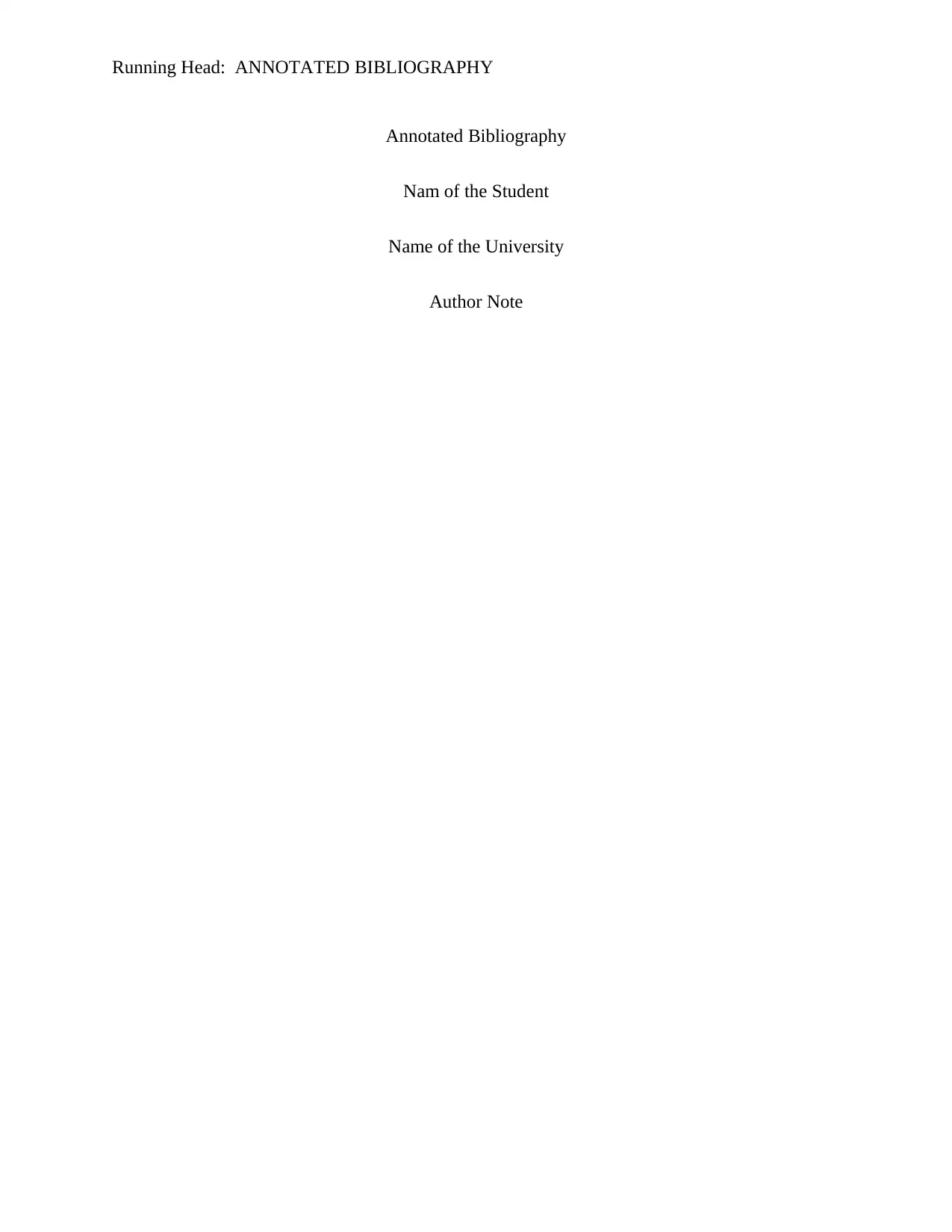
Running Head: ANNOTATED BIBLIOGRAPHY
Annotated Bibliography
Nam of the Student
Name of the University
Author Note
Annotated Bibliography
Nam of the Student
Name of the University
Author Note
Paraphrase This Document
Need a fresh take? Get an instant paraphrase of this document with our AI Paraphraser
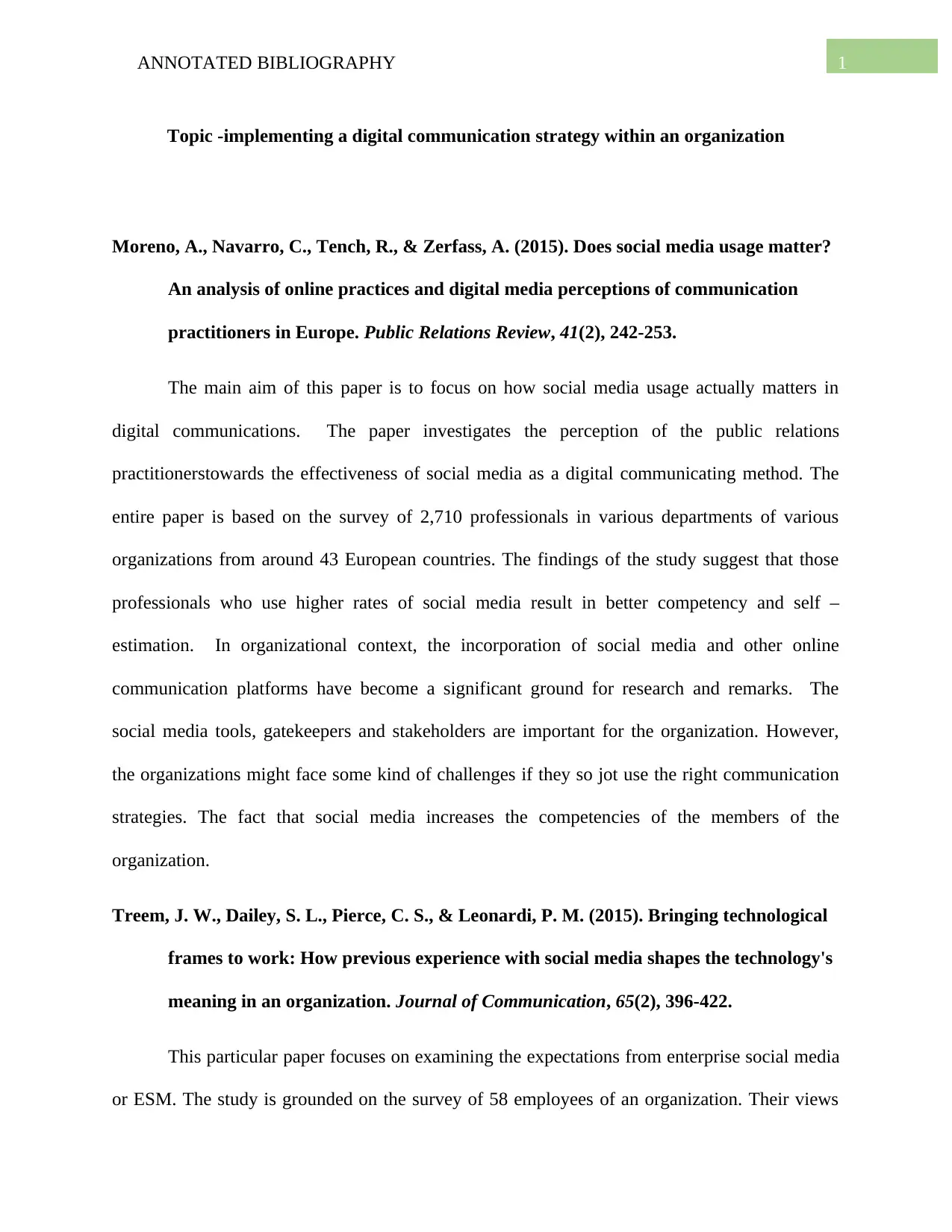
1ANNOTATED BIBLIOGRAPHY
Topic -implementing a digital communication strategy within an organization
Moreno, A., Navarro, C., Tench, R., & Zerfass, A. (2015). Does social media usage matter?
An analysis of online practices and digital media perceptions of communication
practitioners in Europe. Public Relations Review, 41(2), 242-253.
The main aim of this paper is to focus on how social media usage actually matters in
digital communications. The paper investigates the perception of the public relations
practitionerstowards the effectiveness of social media as a digital communicating method. The
entire paper is based on the survey of 2,710 professionals in various departments of various
organizations from around 43 European countries. The findings of the study suggest that those
professionals who use higher rates of social media result in better competency and self –
estimation. In organizational context, the incorporation of social media and other online
communication platforms have become a significant ground for research and remarks. The
social media tools, gatekeepers and stakeholders are important for the organization. However,
the organizations might face some kind of challenges if they so jot use the right communication
strategies. The fact that social media increases the competencies of the members of the
organization.
Treem, J. W., Dailey, S. L., Pierce, C. S., & Leonardi, P. M. (2015). Bringing technological
frames to work: How previous experience with social media shapes the technology's
meaning in an organization. Journal of Communication, 65(2), 396-422.
This particular paper focuses on examining the expectations from enterprise social media
or ESM. The study is grounded on the survey of 58 employees of an organization. Their views
Topic -implementing a digital communication strategy within an organization
Moreno, A., Navarro, C., Tench, R., & Zerfass, A. (2015). Does social media usage matter?
An analysis of online practices and digital media perceptions of communication
practitioners in Europe. Public Relations Review, 41(2), 242-253.
The main aim of this paper is to focus on how social media usage actually matters in
digital communications. The paper investigates the perception of the public relations
practitionerstowards the effectiveness of social media as a digital communicating method. The
entire paper is based on the survey of 2,710 professionals in various departments of various
organizations from around 43 European countries. The findings of the study suggest that those
professionals who use higher rates of social media result in better competency and self –
estimation. In organizational context, the incorporation of social media and other online
communication platforms have become a significant ground for research and remarks. The
social media tools, gatekeepers and stakeholders are important for the organization. However,
the organizations might face some kind of challenges if they so jot use the right communication
strategies. The fact that social media increases the competencies of the members of the
organization.
Treem, J. W., Dailey, S. L., Pierce, C. S., & Leonardi, P. M. (2015). Bringing technological
frames to work: How previous experience with social media shapes the technology's
meaning in an organization. Journal of Communication, 65(2), 396-422.
This particular paper focuses on examining the expectations from enterprise social media
or ESM. The study is grounded on the survey of 58 employees of an organization. Their views
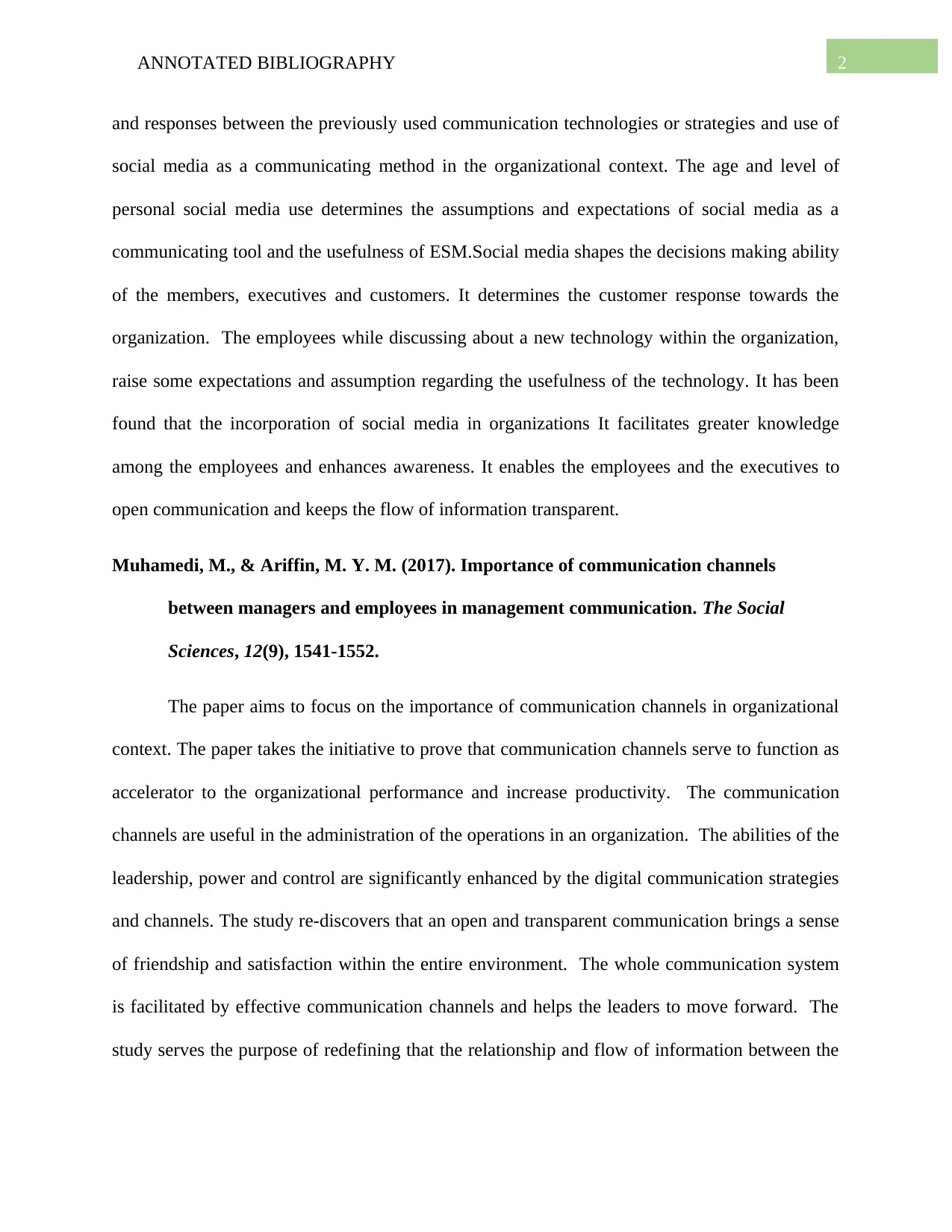
2ANNOTATED BIBLIOGRAPHY
and responses between the previously used communication technologies or strategies and use of
social media as a communicating method in the organizational context. The age and level of
personal social media use determines the assumptions and expectations of social media as a
communicating tool and the usefulness of ESM.Social media shapes the decisions making ability
of the members, executives and customers. It determines the customer response towards the
organization. The employees while discussing about a new technology within the organization,
raise some expectations and assumption regarding the usefulness of the technology. It has been
found that the incorporation of social media in organizations It facilitates greater knowledge
among the employees and enhances awareness. It enables the employees and the executives to
open communication and keeps the flow of information transparent.
Muhamedi, M., & Ariffin, M. Y. M. (2017). Importance of communication channels
between managers and employees in management communication. The Social
Sciences, 12(9), 1541-1552.
The paper aims to focus on the importance of communication channels in organizational
context. The paper takes the initiative to prove that communication channels serve to function as
accelerator to the organizational performance and increase productivity. The communication
channels are useful in the administration of the operations in an organization. The abilities of the
leadership, power and control are significantly enhanced by the digital communication strategies
and channels. The study re-discovers that an open and transparent communication brings a sense
of friendship and satisfaction within the entire environment. The whole communication system
is facilitated by effective communication channels and helps the leaders to move forward. The
study serves the purpose of redefining that the relationship and flow of information between the
and responses between the previously used communication technologies or strategies and use of
social media as a communicating method in the organizational context. The age and level of
personal social media use determines the assumptions and expectations of social media as a
communicating tool and the usefulness of ESM.Social media shapes the decisions making ability
of the members, executives and customers. It determines the customer response towards the
organization. The employees while discussing about a new technology within the organization,
raise some expectations and assumption regarding the usefulness of the technology. It has been
found that the incorporation of social media in organizations It facilitates greater knowledge
among the employees and enhances awareness. It enables the employees and the executives to
open communication and keeps the flow of information transparent.
Muhamedi, M., & Ariffin, M. Y. M. (2017). Importance of communication channels
between managers and employees in management communication. The Social
Sciences, 12(9), 1541-1552.
The paper aims to focus on the importance of communication channels in organizational
context. The paper takes the initiative to prove that communication channels serve to function as
accelerator to the organizational performance and increase productivity. The communication
channels are useful in the administration of the operations in an organization. The abilities of the
leadership, power and control are significantly enhanced by the digital communication strategies
and channels. The study re-discovers that an open and transparent communication brings a sense
of friendship and satisfaction within the entire environment. The whole communication system
is facilitated by effective communication channels and helps the leaders to move forward. The
study serves the purpose of redefining that the relationship and flow of information between the
⊘ This is a preview!⊘
Do you want full access?
Subscribe today to unlock all pages.

Trusted by 1+ million students worldwide
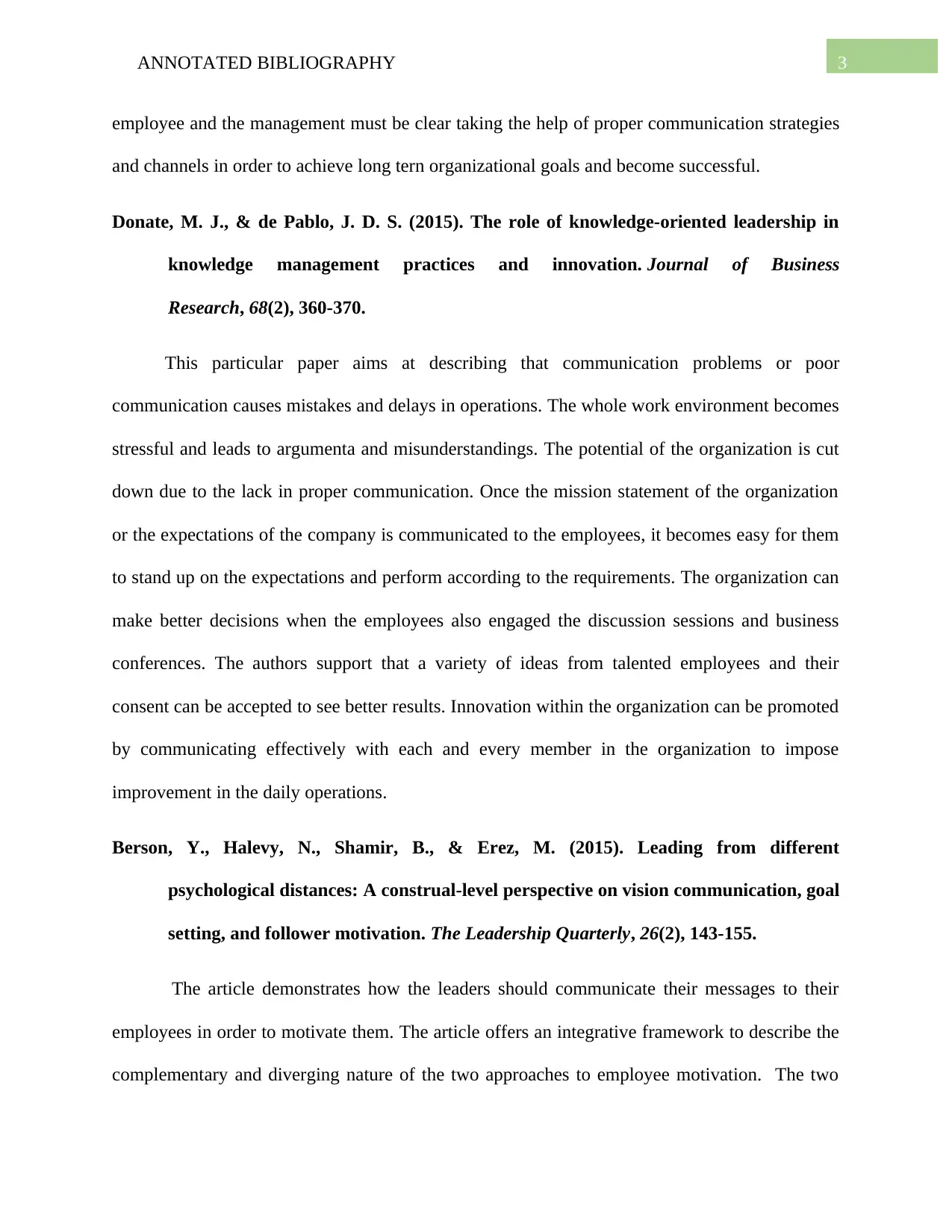
3ANNOTATED BIBLIOGRAPHY
employee and the management must be clear taking the help of proper communication strategies
and channels in order to achieve long tern organizational goals and become successful.
Donate, M. J., & de Pablo, J. D. S. (2015). The role of knowledge-oriented leadership in
knowledge management practices and innovation. Journal of Business
Research, 68(2), 360-370.
This particular paper aims at describing that communication problems or poor
communication causes mistakes and delays in operations. The whole work environment becomes
stressful and leads to argumenta and misunderstandings. The potential of the organization is cut
down due to the lack in proper communication. Once the mission statement of the organization
or the expectations of the company is communicated to the employees, it becomes easy for them
to stand up on the expectations and perform according to the requirements. The organization can
make better decisions when the employees also engaged the discussion sessions and business
conferences. The authors support that a variety of ideas from talented employees and their
consent can be accepted to see better results. Innovation within the organization can be promoted
by communicating effectively with each and every member in the organization to impose
improvement in the daily operations.
Berson, Y., Halevy, N., Shamir, B., & Erez, M. (2015). Leading from different
psychological distances: A construal-level perspective on vision communication, goal
setting, and follower motivation. The Leadership Quarterly, 26(2), 143-155.
The article demonstrates how the leaders should communicate their messages to their
employees in order to motivate them. The article offers an integrative framework to describe the
complementary and diverging nature of the two approaches to employee motivation. The two
employee and the management must be clear taking the help of proper communication strategies
and channels in order to achieve long tern organizational goals and become successful.
Donate, M. J., & de Pablo, J. D. S. (2015). The role of knowledge-oriented leadership in
knowledge management practices and innovation. Journal of Business
Research, 68(2), 360-370.
This particular paper aims at describing that communication problems or poor
communication causes mistakes and delays in operations. The whole work environment becomes
stressful and leads to argumenta and misunderstandings. The potential of the organization is cut
down due to the lack in proper communication. Once the mission statement of the organization
or the expectations of the company is communicated to the employees, it becomes easy for them
to stand up on the expectations and perform according to the requirements. The organization can
make better decisions when the employees also engaged the discussion sessions and business
conferences. The authors support that a variety of ideas from talented employees and their
consent can be accepted to see better results. Innovation within the organization can be promoted
by communicating effectively with each and every member in the organization to impose
improvement in the daily operations.
Berson, Y., Halevy, N., Shamir, B., & Erez, M. (2015). Leading from different
psychological distances: A construal-level perspective on vision communication, goal
setting, and follower motivation. The Leadership Quarterly, 26(2), 143-155.
The article demonstrates how the leaders should communicate their messages to their
employees in order to motivate them. The article offers an integrative framework to describe the
complementary and diverging nature of the two approaches to employee motivation. The two
Paraphrase This Document
Need a fresh take? Get an instant paraphrase of this document with our AI Paraphraser
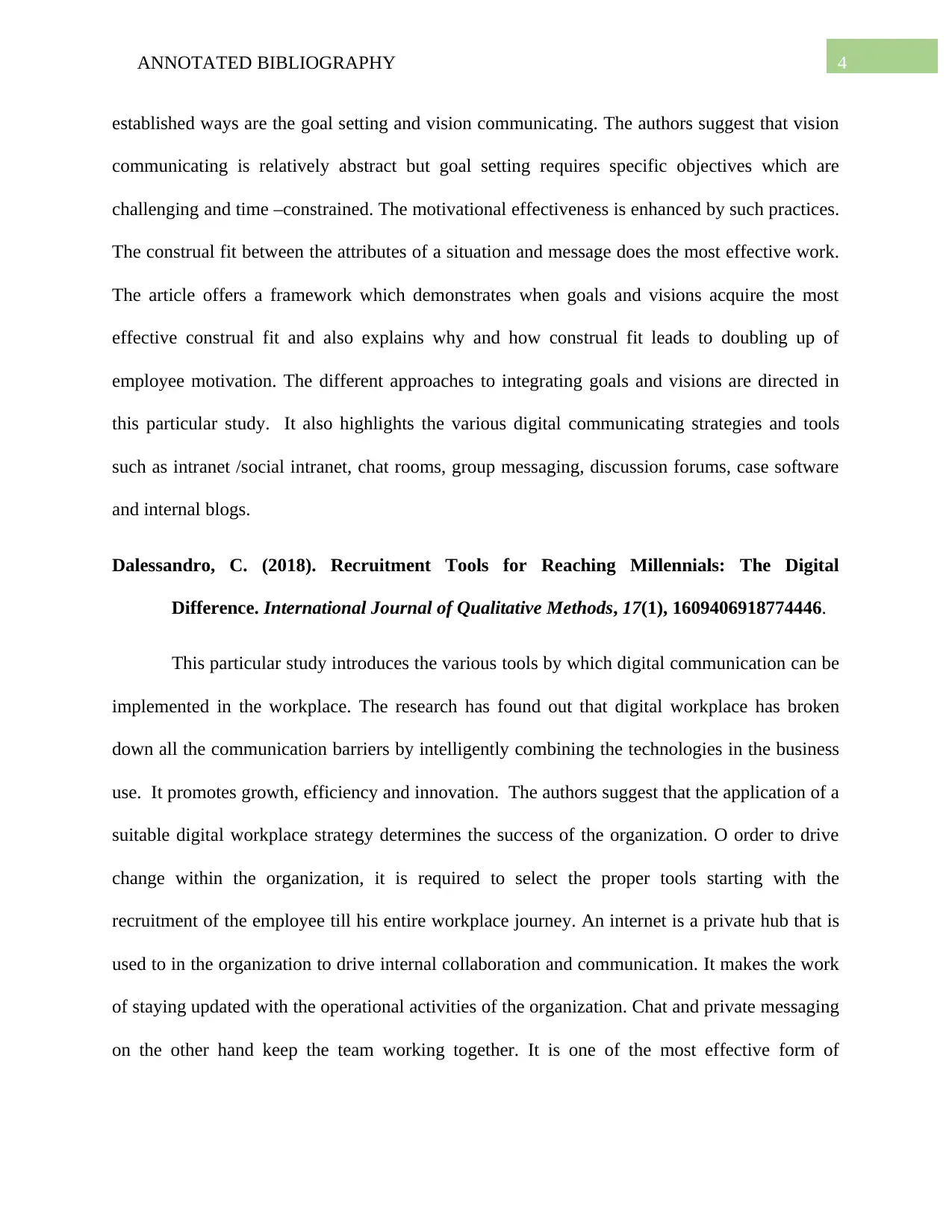
4ANNOTATED BIBLIOGRAPHY
established ways are the goal setting and vision communicating. The authors suggest that vision
communicating is relatively abstract but goal setting requires specific objectives which are
challenging and time –constrained. The motivational effectiveness is enhanced by such practices.
The construal fit between the attributes of a situation and message does the most effective work.
The article offers a framework which demonstrates when goals and visions acquire the most
effective construal fit and also explains why and how construal fit leads to doubling up of
employee motivation. The different approaches to integrating goals and visions are directed in
this particular study. It also highlights the various digital communicating strategies and tools
such as intranet /social intranet, chat rooms, group messaging, discussion forums, case software
and internal blogs.
Dalessandro, C. (2018). Recruitment Tools for Reaching Millennials: The Digital
Difference. International Journal of Qualitative Methods, 17(1), 1609406918774446.
This particular study introduces the various tools by which digital communication can be
implemented in the workplace. The research has found out that digital workplace has broken
down all the communication barriers by intelligently combining the technologies in the business
use. It promotes growth, efficiency and innovation. The authors suggest that the application of a
suitable digital workplace strategy determines the success of the organization. O order to drive
change within the organization, it is required to select the proper tools starting with the
recruitment of the employee till his entire workplace journey. An internet is a private hub that is
used to in the organization to drive internal collaboration and communication. It makes the work
of staying updated with the operational activities of the organization. Chat and private messaging
on the other hand keep the team working together. It is one of the most effective form of
established ways are the goal setting and vision communicating. The authors suggest that vision
communicating is relatively abstract but goal setting requires specific objectives which are
challenging and time –constrained. The motivational effectiveness is enhanced by such practices.
The construal fit between the attributes of a situation and message does the most effective work.
The article offers a framework which demonstrates when goals and visions acquire the most
effective construal fit and also explains why and how construal fit leads to doubling up of
employee motivation. The different approaches to integrating goals and visions are directed in
this particular study. It also highlights the various digital communicating strategies and tools
such as intranet /social intranet, chat rooms, group messaging, discussion forums, case software
and internal blogs.
Dalessandro, C. (2018). Recruitment Tools for Reaching Millennials: The Digital
Difference. International Journal of Qualitative Methods, 17(1), 1609406918774446.
This particular study introduces the various tools by which digital communication can be
implemented in the workplace. The research has found out that digital workplace has broken
down all the communication barriers by intelligently combining the technologies in the business
use. It promotes growth, efficiency and innovation. The authors suggest that the application of a
suitable digital workplace strategy determines the success of the organization. O order to drive
change within the organization, it is required to select the proper tools starting with the
recruitment of the employee till his entire workplace journey. An internet is a private hub that is
used to in the organization to drive internal collaboration and communication. It makes the work
of staying updated with the operational activities of the organization. Chat and private messaging
on the other hand keep the team working together. It is one of the most effective form of
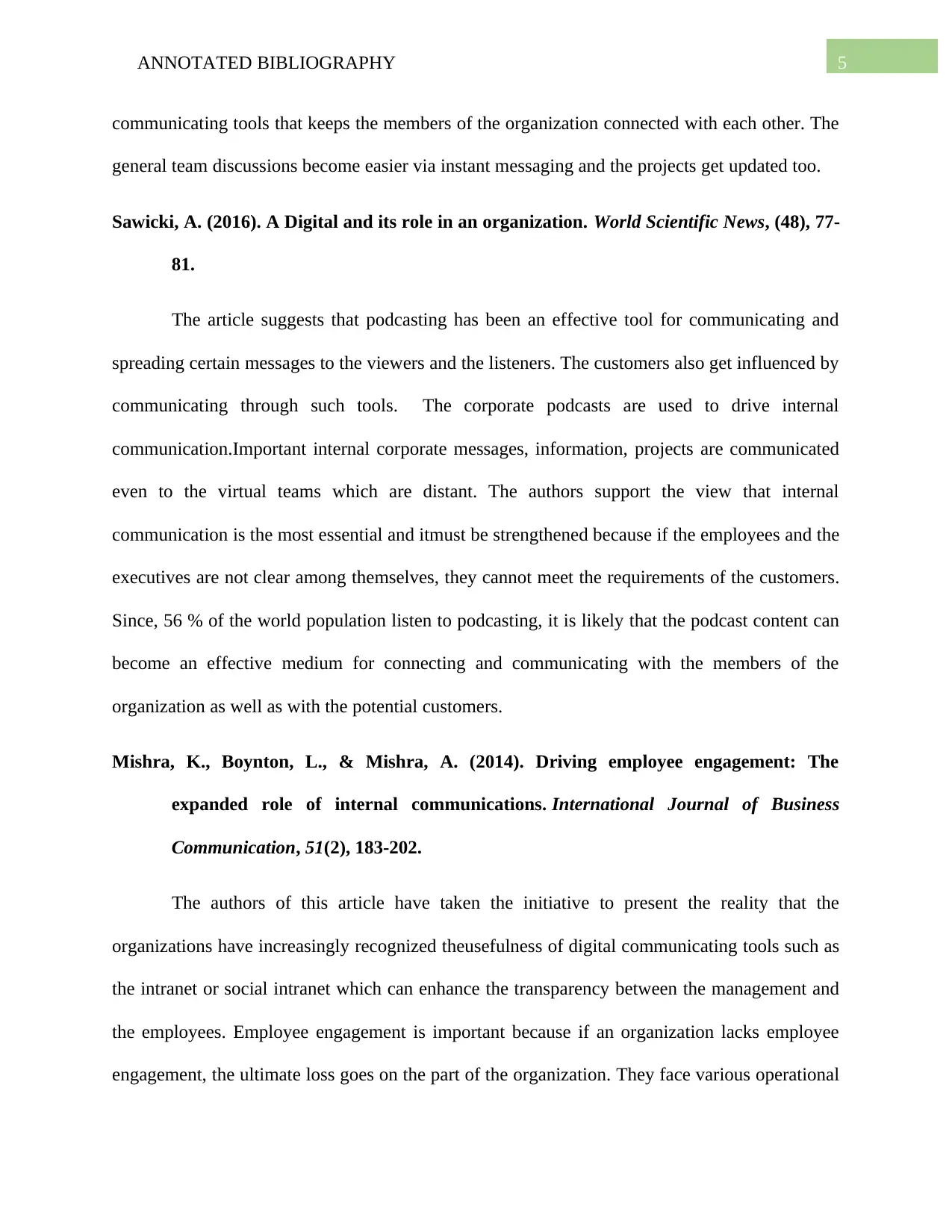
5ANNOTATED BIBLIOGRAPHY
communicating tools that keeps the members of the organization connected with each other. The
general team discussions become easier via instant messaging and the projects get updated too.
Sawicki, A. (2016). A Digital and its role in an organization. World Scientific News, (48), 77-
81.
The article suggests that podcasting has been an effective tool for communicating and
spreading certain messages to the viewers and the listeners. The customers also get influenced by
communicating through such tools. The corporate podcasts are used to drive internal
communication.Important internal corporate messages, information, projects are communicated
even to the virtual teams which are distant. The authors support the view that internal
communication is the most essential and itmust be strengthened because if the employees and the
executives are not clear among themselves, they cannot meet the requirements of the customers.
Since, 56 % of the world population listen to podcasting, it is likely that the podcast content can
become an effective medium for connecting and communicating with the members of the
organization as well as with the potential customers.
Mishra, K., Boynton, L., & Mishra, A. (2014). Driving employee engagement: The
expanded role of internal communications. International Journal of Business
Communication, 51(2), 183-202.
The authors of this article have taken the initiative to present the reality that the
organizations have increasingly recognized theusefulness of digital communicating tools such as
the intranet or social intranet which can enhance the transparency between the management and
the employees. Employee engagement is important because if an organization lacks employee
engagement, the ultimate loss goes on the part of the organization. They face various operational
communicating tools that keeps the members of the organization connected with each other. The
general team discussions become easier via instant messaging and the projects get updated too.
Sawicki, A. (2016). A Digital and its role in an organization. World Scientific News, (48), 77-
81.
The article suggests that podcasting has been an effective tool for communicating and
spreading certain messages to the viewers and the listeners. The customers also get influenced by
communicating through such tools. The corporate podcasts are used to drive internal
communication.Important internal corporate messages, information, projects are communicated
even to the virtual teams which are distant. The authors support the view that internal
communication is the most essential and itmust be strengthened because if the employees and the
executives are not clear among themselves, they cannot meet the requirements of the customers.
Since, 56 % of the world population listen to podcasting, it is likely that the podcast content can
become an effective medium for connecting and communicating with the members of the
organization as well as with the potential customers.
Mishra, K., Boynton, L., & Mishra, A. (2014). Driving employee engagement: The
expanded role of internal communications. International Journal of Business
Communication, 51(2), 183-202.
The authors of this article have taken the initiative to present the reality that the
organizations have increasingly recognized theusefulness of digital communicating tools such as
the intranet or social intranet which can enhance the transparency between the management and
the employees. Employee engagement is important because if an organization lacks employee
engagement, the ultimate loss goes on the part of the organization. They face various operational
⊘ This is a preview!⊘
Do you want full access?
Subscribe today to unlock all pages.

Trusted by 1+ million students worldwide
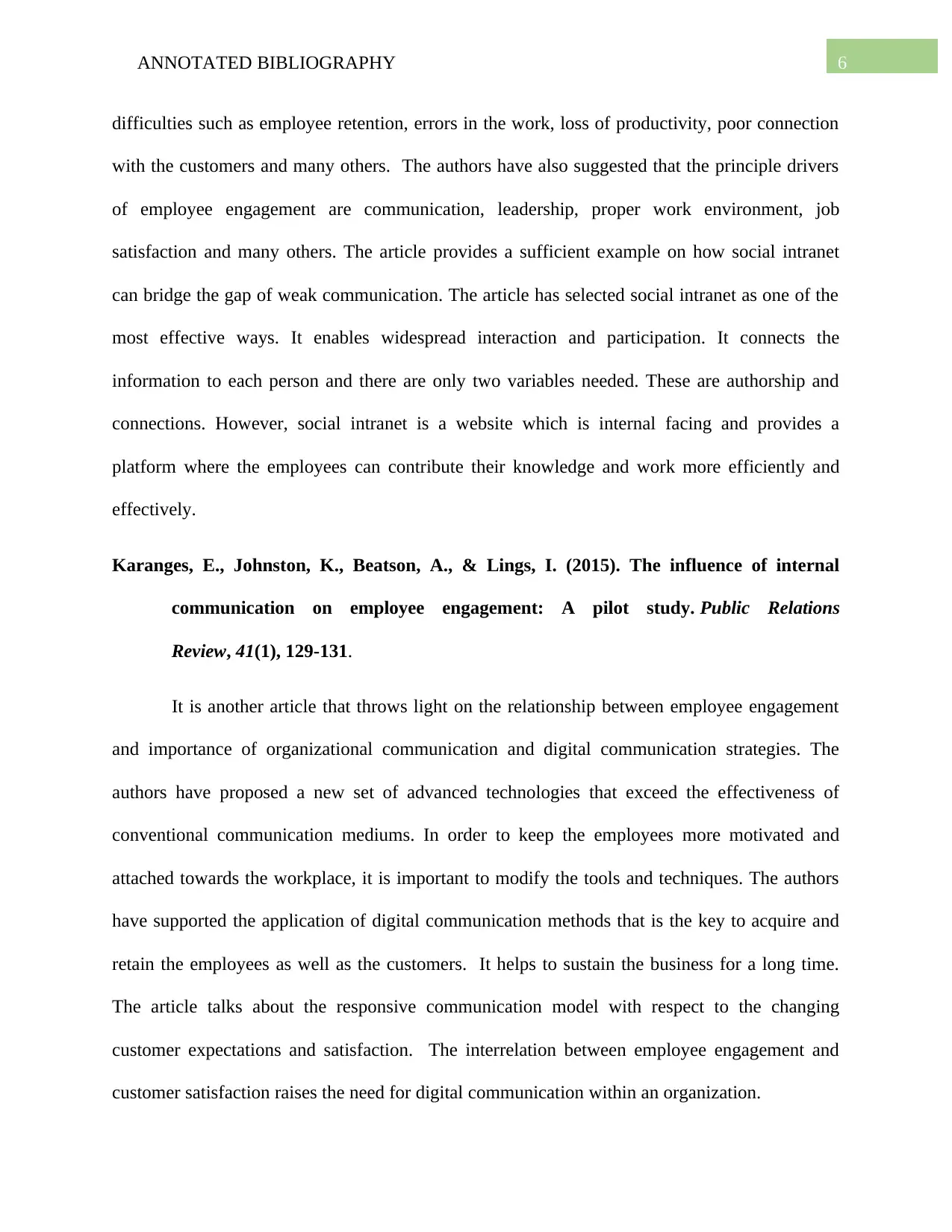
6ANNOTATED BIBLIOGRAPHY
difficulties such as employee retention, errors in the work, loss of productivity, poor connection
with the customers and many others. The authors have also suggested that the principle drivers
of employee engagement are communication, leadership, proper work environment, job
satisfaction and many others. The article provides a sufficient example on how social intranet
can bridge the gap of weak communication. The article has selected social intranet as one of the
most effective ways. It enables widespread interaction and participation. It connects the
information to each person and there are only two variables needed. These are authorship and
connections. However, social intranet is a website which is internal facing and provides a
platform where the employees can contribute their knowledge and work more efficiently and
effectively.
Karanges, E., Johnston, K., Beatson, A., & Lings, I. (2015). The influence of internal
communication on employee engagement: A pilot study. Public Relations
Review, 41(1), 129-131.
It is another article that throws light on the relationship between employee engagement
and importance of organizational communication and digital communication strategies. The
authors have proposed a new set of advanced technologies that exceed the effectiveness of
conventional communication mediums. In order to keep the employees more motivated and
attached towards the workplace, it is important to modify the tools and techniques. The authors
have supported the application of digital communication methods that is the key to acquire and
retain the employees as well as the customers. It helps to sustain the business for a long time.
The article talks about the responsive communication model with respect to the changing
customer expectations and satisfaction. The interrelation between employee engagement and
customer satisfaction raises the need for digital communication within an organization.
difficulties such as employee retention, errors in the work, loss of productivity, poor connection
with the customers and many others. The authors have also suggested that the principle drivers
of employee engagement are communication, leadership, proper work environment, job
satisfaction and many others. The article provides a sufficient example on how social intranet
can bridge the gap of weak communication. The article has selected social intranet as one of the
most effective ways. It enables widespread interaction and participation. It connects the
information to each person and there are only two variables needed. These are authorship and
connections. However, social intranet is a website which is internal facing and provides a
platform where the employees can contribute their knowledge and work more efficiently and
effectively.
Karanges, E., Johnston, K., Beatson, A., & Lings, I. (2015). The influence of internal
communication on employee engagement: A pilot study. Public Relations
Review, 41(1), 129-131.
It is another article that throws light on the relationship between employee engagement
and importance of organizational communication and digital communication strategies. The
authors have proposed a new set of advanced technologies that exceed the effectiveness of
conventional communication mediums. In order to keep the employees more motivated and
attached towards the workplace, it is important to modify the tools and techniques. The authors
have supported the application of digital communication methods that is the key to acquire and
retain the employees as well as the customers. It helps to sustain the business for a long time.
The article talks about the responsive communication model with respect to the changing
customer expectations and satisfaction. The interrelation between employee engagement and
customer satisfaction raises the need for digital communication within an organization.
Paraphrase This Document
Need a fresh take? Get an instant paraphrase of this document with our AI Paraphraser
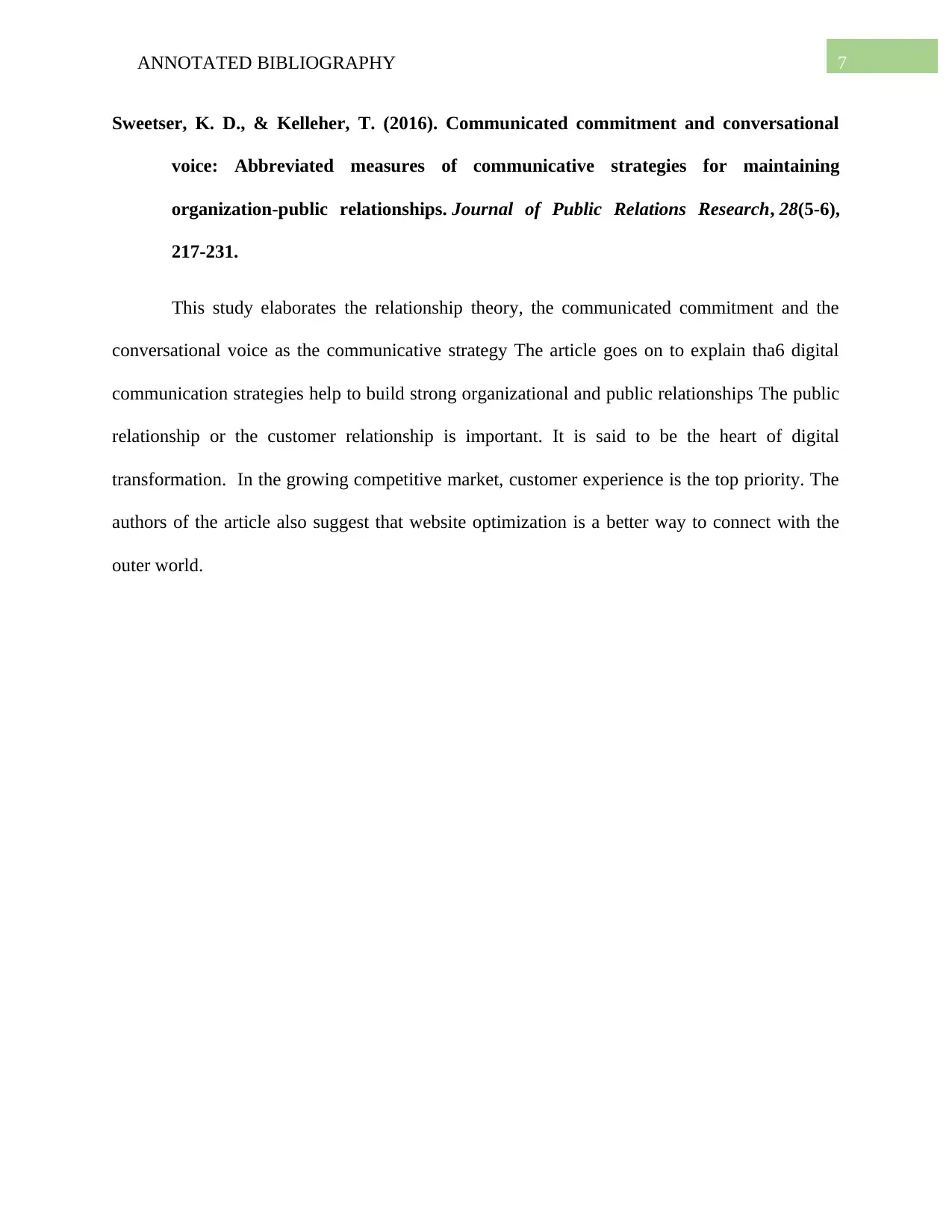
7ANNOTATED BIBLIOGRAPHY
Sweetser, K. D., & Kelleher, T. (2016). Communicated commitment and conversational
voice: Abbreviated measures of communicative strategies for maintaining
organization-public relationships. Journal of Public Relations Research, 28(5-6),
217-231.
This study elaborates the relationship theory, the communicated commitment and the
conversational voice as the communicative strategy The article goes on to explain tha6 digital
communication strategies help to build strong organizational and public relationships The public
relationship or the customer relationship is important. It is said to be the heart of digital
transformation. In the growing competitive market, customer experience is the top priority. The
authors of the article also suggest that website optimization is a better way to connect with the
outer world.
Sweetser, K. D., & Kelleher, T. (2016). Communicated commitment and conversational
voice: Abbreviated measures of communicative strategies for maintaining
organization-public relationships. Journal of Public Relations Research, 28(5-6),
217-231.
This study elaborates the relationship theory, the communicated commitment and the
conversational voice as the communicative strategy The article goes on to explain tha6 digital
communication strategies help to build strong organizational and public relationships The public
relationship or the customer relationship is important. It is said to be the heart of digital
transformation. In the growing competitive market, customer experience is the top priority. The
authors of the article also suggest that website optimization is a better way to connect with the
outer world.
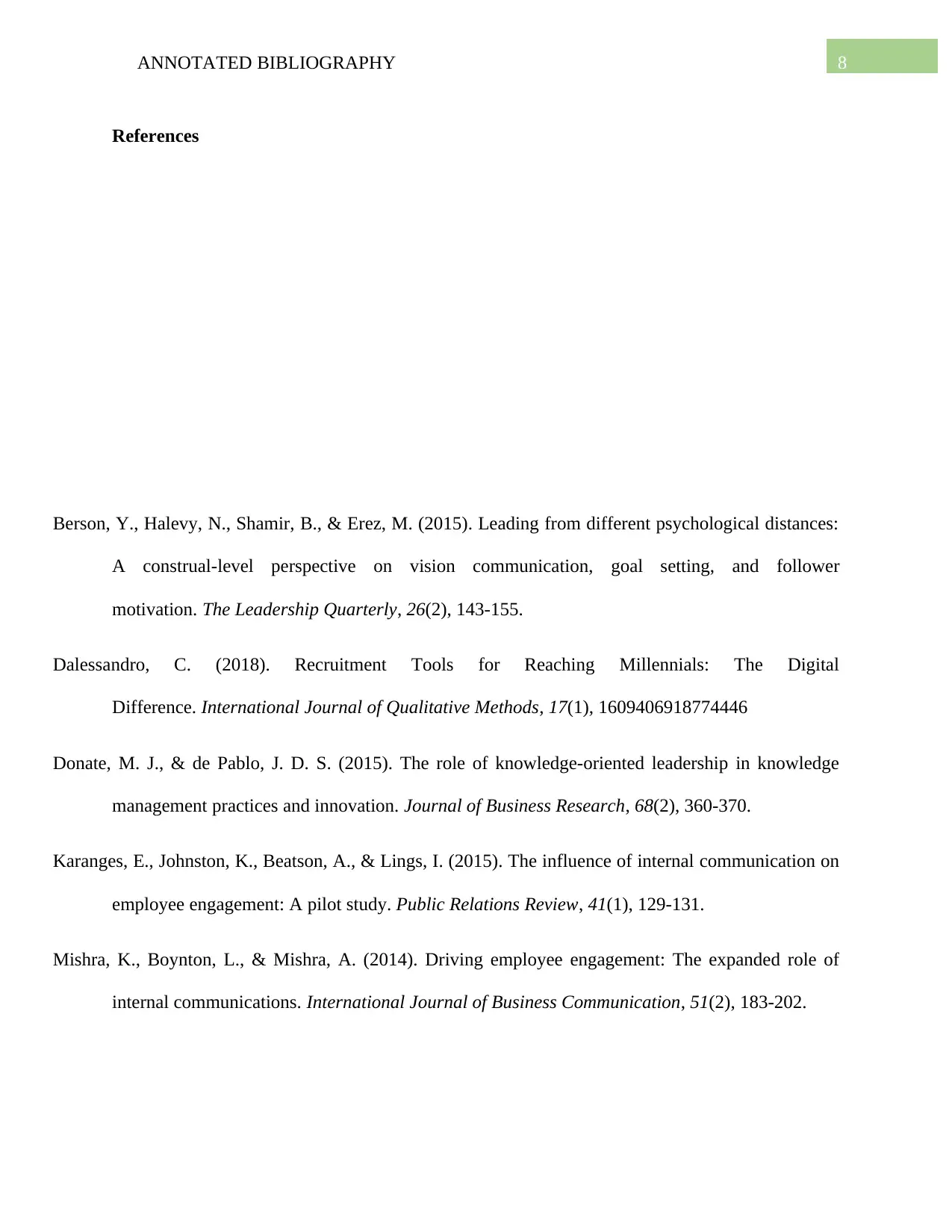
8ANNOTATED BIBLIOGRAPHY
References
Berson, Y., Halevy, N., Shamir, B., & Erez, M. (2015). Leading from different psychological distances:
A construal-level perspective on vision communication, goal setting, and follower
motivation. The Leadership Quarterly, 26(2), 143-155.
Dalessandro, C. (2018). Recruitment Tools for Reaching Millennials: The Digital
Difference. International Journal of Qualitative Methods, 17(1), 1609406918774446
Donate, M. J., & de Pablo, J. D. S. (2015). The role of knowledge-oriented leadership in knowledge
management practices and innovation. Journal of Business Research, 68(2), 360-370.
Karanges, E., Johnston, K., Beatson, A., & Lings, I. (2015). The influence of internal communication on
employee engagement: A pilot study. Public Relations Review, 41(1), 129-131.
Mishra, K., Boynton, L., & Mishra, A. (2014). Driving employee engagement: The expanded role of
internal communications. International Journal of Business Communication, 51(2), 183-202.
References
Berson, Y., Halevy, N., Shamir, B., & Erez, M. (2015). Leading from different psychological distances:
A construal-level perspective on vision communication, goal setting, and follower
motivation. The Leadership Quarterly, 26(2), 143-155.
Dalessandro, C. (2018). Recruitment Tools for Reaching Millennials: The Digital
Difference. International Journal of Qualitative Methods, 17(1), 1609406918774446
Donate, M. J., & de Pablo, J. D. S. (2015). The role of knowledge-oriented leadership in knowledge
management practices and innovation. Journal of Business Research, 68(2), 360-370.
Karanges, E., Johnston, K., Beatson, A., & Lings, I. (2015). The influence of internal communication on
employee engagement: A pilot study. Public Relations Review, 41(1), 129-131.
Mishra, K., Boynton, L., & Mishra, A. (2014). Driving employee engagement: The expanded role of
internal communications. International Journal of Business Communication, 51(2), 183-202.
⊘ This is a preview!⊘
Do you want full access?
Subscribe today to unlock all pages.

Trusted by 1+ million students worldwide
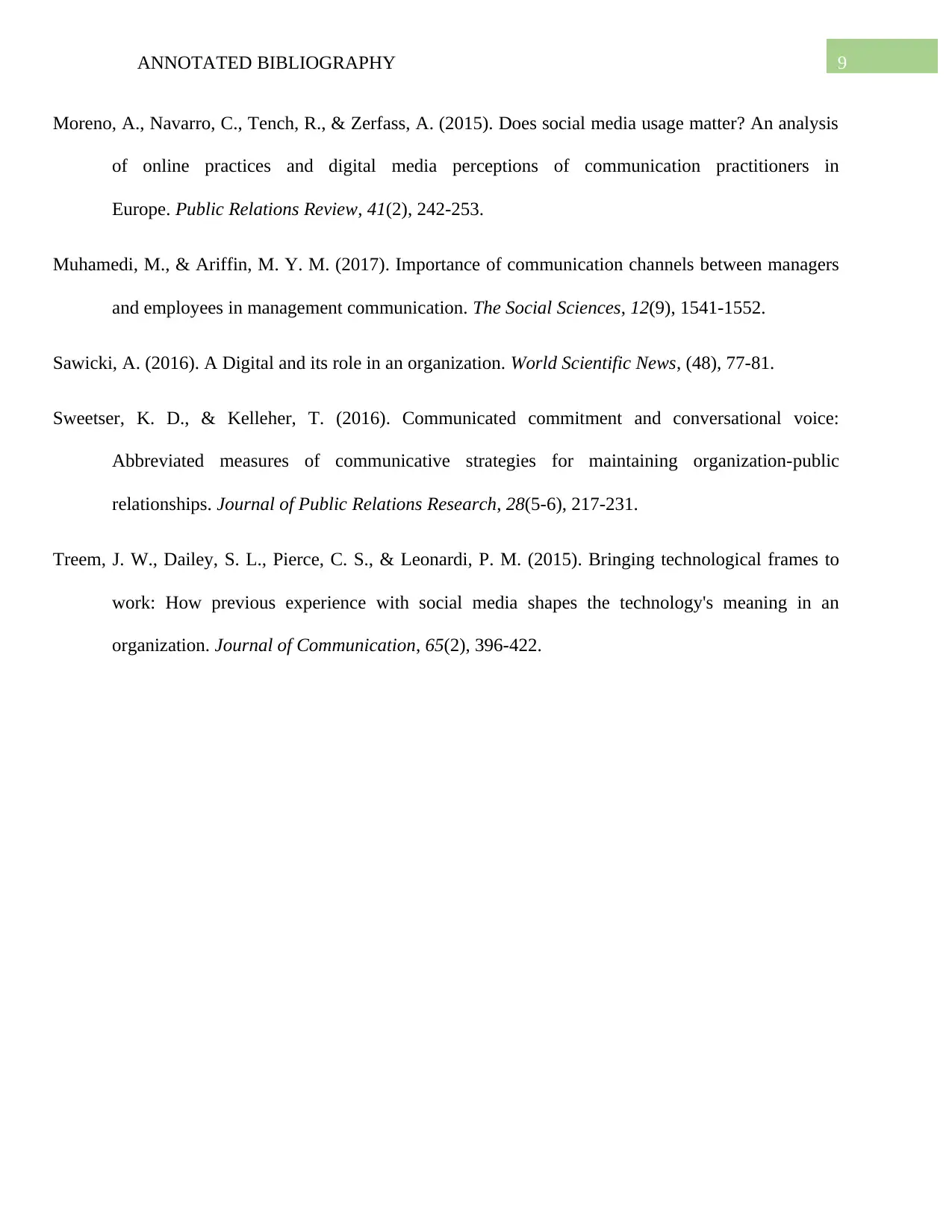
9ANNOTATED BIBLIOGRAPHY
Moreno, A., Navarro, C., Tench, R., & Zerfass, A. (2015). Does social media usage matter? An analysis
of online practices and digital media perceptions of communication practitioners in
Europe. Public Relations Review, 41(2), 242-253.
Muhamedi, M., & Ariffin, M. Y. M. (2017). Importance of communication channels between managers
and employees in management communication. The Social Sciences, 12(9), 1541-1552.
Sawicki, A. (2016). A Digital and its role in an organization. World Scientific News, (48), 77-81.
Sweetser, K. D., & Kelleher, T. (2016). Communicated commitment and conversational voice:
Abbreviated measures of communicative strategies for maintaining organization-public
relationships. Journal of Public Relations Research, 28(5-6), 217-231.
Treem, J. W., Dailey, S. L., Pierce, C. S., & Leonardi, P. M. (2015). Bringing technological frames to
work: How previous experience with social media shapes the technology's meaning in an
organization. Journal of Communication, 65(2), 396-422.
Moreno, A., Navarro, C., Tench, R., & Zerfass, A. (2015). Does social media usage matter? An analysis
of online practices and digital media perceptions of communication practitioners in
Europe. Public Relations Review, 41(2), 242-253.
Muhamedi, M., & Ariffin, M. Y. M. (2017). Importance of communication channels between managers
and employees in management communication. The Social Sciences, 12(9), 1541-1552.
Sawicki, A. (2016). A Digital and its role in an organization. World Scientific News, (48), 77-81.
Sweetser, K. D., & Kelleher, T. (2016). Communicated commitment and conversational voice:
Abbreviated measures of communicative strategies for maintaining organization-public
relationships. Journal of Public Relations Research, 28(5-6), 217-231.
Treem, J. W., Dailey, S. L., Pierce, C. S., & Leonardi, P. M. (2015). Bringing technological frames to
work: How previous experience with social media shapes the technology's meaning in an
organization. Journal of Communication, 65(2), 396-422.
1 out of 10
Related Documents
Your All-in-One AI-Powered Toolkit for Academic Success.
+13062052269
info@desklib.com
Available 24*7 on WhatsApp / Email
![[object Object]](/_next/static/media/star-bottom.7253800d.svg)
Unlock your academic potential
Copyright © 2020–2025 A2Z Services. All Rights Reserved. Developed and managed by ZUCOL.



